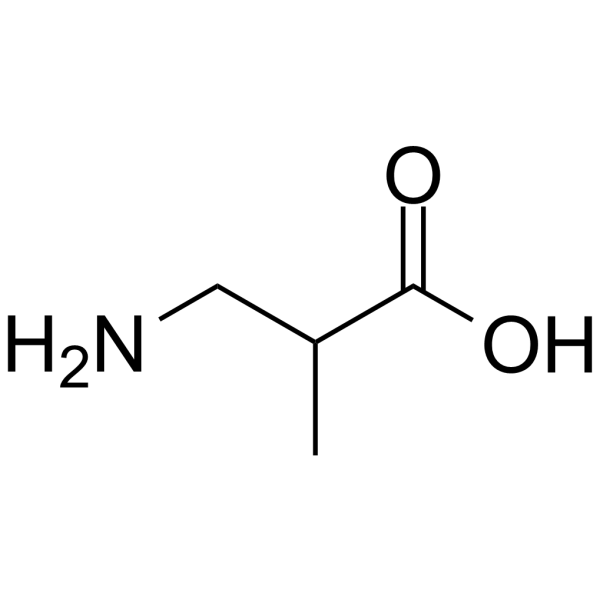上海金畔生物科技有限公司为生命科学和医药研发人员提供生物活性分子抑制剂、激动剂、特异性抑制剂、化合物库、重组蛋白、同位素标记物,专注于信号通路和疾病研究领域。
3-Amino-2-methylpropanoic acid 纯度: ≥98.0%
3-Amino-2-methylpropanoic acid 会诱导白色脂肪发生褐变,并与心血管代谢危险因素成反比。

3-Amino-2-methylpropanoic acid Chemical Structure
CAS No. : 144-90-1
| 规格 | 价格 | 是否有货 | 数量 |
|---|---|---|---|
| 10 mM * 1 mL in Water | ¥110 | In-stock | |
| 100 mg | ¥100 | In-stock | |
| 200 mg | 询价 | ||
| 500 mg | 询价 |
* Please select Quantity before adding items.
3-Amino-2-methylpropanoic acid 相关产品
•相关化合物库:
- Natural Product Library Plus
- Bioactive Compound Library Plus
- Metabolism/Protease Compound Library
- Natural Product Library
- Human Endogenous Metabolite Compound Library
- Lipid Compound Library
- Anti-Cardiovascular Disease Compound Library
- Gut Microbial Metabolite Library
- Microbial Metabolite Library
- Food-Sourced Compound Library
- Human Metabolite Library
- Animal-Sourced Natural Product Library
- Multi-Target Compound Library
| 生物活性 |
3-Amino-2-methylpropanoic acid could induce browning of white fat and hepatic β-oxidation and is inversely correlated with cardiometabolic risk factors. |
||||||||||||
|---|---|---|---|---|---|---|---|---|---|---|---|---|---|
| IC50 & Target |
|
||||||||||||
| 体内研究 (In Vivo) |
Weight is slightly decreased in the mice by the end of 3-Amino-2-methylpropanoic acid (BAIBA) treatment. Analysis of body composition using MRI demonstrates BAIBA treatment significantly decreases body fat in the mice. Consistent with the effects on thermogenic and β-oxidation gene expression and body weights, analysis with metabolic cages indicates that oxygen consumption (VO2) and whole body energy expenditure are increased in the BAIBA treated mice without any significant difference in activity or food intake. The mice are also challenged with an intraperitoneal glucose tolerance test (IPGTT). BAIBA is found to significantly improve the glucose tolerance in the mice as determined by the area under the curve of the IPGTT[1]. Shanghai Jinpan Biotech Co Ltd has not independently confirmed the accuracy of these methods. They are for reference only. |
||||||||||||
| 分子量 |
103.12 |
||||||||||||
| Formula |
C4H9NO2 |
||||||||||||
| CAS 号 |
144-90-1 |
||||||||||||
| 性状 |
固体 |
||||||||||||
| 颜色 |
White to off-white |
||||||||||||
| 结构分类 |
|
||||||||||||
| 初始来源 |
|
||||||||||||
| 运输条件 |
Room temperature in continental US; may vary elsewhere. |
||||||||||||
| 储存方式 |
4°C, protect from light *In solvent : -80°C, 6 months; -20°C, 1 month (protect from light) |
||||||||||||
| 溶解性数据 |
In Vitro:
H2O 中的溶解度 : 100 mg/mL (969.74 mM; 超声助溶) DMSO 中的溶解度 : 1 mg/mL (9.70 mM; 超声助溶; 吸湿的 DMSO 对产品的溶解度有显著影响,请使用新开封的 DMSO) 配制储备液
查看完整储备液配制表
* 请根据产品在不同溶剂中的溶解度选择合适的溶剂配制储备液;一旦配成溶液,请分装保存,避免反复冻融造成的产品失效。 * 备注:如您选择水作为储备液,请稀释至工作液后,再用 0.22 μm 的滤膜过滤除菌后使用。
Mass (g) = Concentration (mol/L) × Volume (L) × Molecular Weight (g/mol)
Concentration (start) × Volume (start) = Concentration (final) × Volume (final) This equation is commonly abbreviated as: C1V1 = C2V2
In Vivo:
以下溶解方案,请直接配置工作液。建议现用现配,在短期内尽快用完。 以下溶剂前显示的百分比是指该溶剂在您配制终溶液中的体积占比; 如在配制过程中出现沉淀、析出现象,可以通过加热和/或超声的方式助溶。
动物溶解方案计算器
请输入动物实验的基本信息:
给药剂量 mg/kg 动物的平均体重 g 每只动物的给药体积 μL 动物数量 只 由于实验过程有损耗,建议您多配一只动物的量
计算结果
工作液所需浓度 : mg/mL
该产品水溶性佳,请具体参考实测 水 / PBS / Saline 中的溶解度数据。
免费服务热线:021-50837765
E-mail:sales@jinpanbio.com 技术支持电话:021-50837765 技术支持邮箱:sales@jinpanbio.com |
||||||||||||
| 纯度 & 产品资料 |
纯度: ≥98.0%
Data Sheet (608 KB) SDS (0 KB)
COA (188 KB) HNMR (242 KB) MS (68 KB) 产品使用指南 (1538 KB) |
||||||||||||
| 参考文献 |
|
| Animal Administration [1] |
Mice[1] Six week old mice are either treated with 3-Amino-2-methylpropanoic acid (BAIBA:100 mg/kg/day) or remains untreated (control mice). Their weights are monitored weekly[1]. Shanghai Jinpan Biotech Co Ltd has not independently confirmed the accuracy of these methods. They are for reference only. |
|---|---|
| 参考文献 |
|
所有产品仅用作科学研究或药证申报,我们不为任何个人用途提供产品和服务
